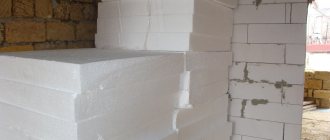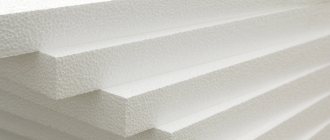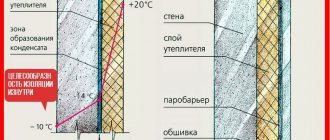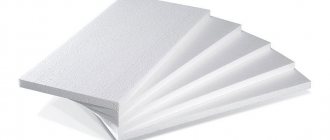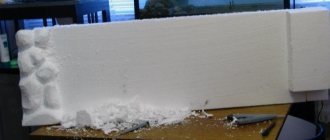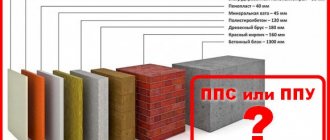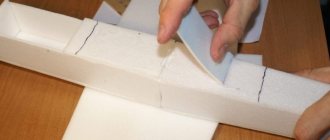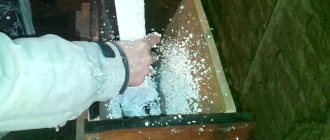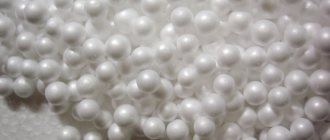What material features need to be taken into account
More than 90% of the volume in the material is air. It is enclosed in small round plastic balls glued to each other. This structure makes the foam lightweight, perfectly retains heat and insulates sounds, which are valuable properties for insulating various structures.
But at the same time, it is very unstable to mechanical loads: it breaks easily from impacts and other influences. When you try to cut or saw a slab, its surface is crushed, and the material itself crumbles badly, since the weak connection between the balls cannot withstand the pressure.
As a result, the cut line turns out to be rough, and in the process a large number of crumbled plastic particles are formed, which are highly electrified. Therefore, before cutting polystyrene foam at home, you need to think about the upcoming cleaning and move the process outside or cover the floor with unnecessary film.
Styrofoam balls stick to surfaces and are difficult to collect Source 2.bp.blogspot.com
The most accurate way to do this job is to use a thin and very sharp blade, and without using excessive force.
Another feature of the material is its fusibility. It does not burn very readily, but melts at a high temperature, which is a big drawback from the point of view of using the material, but simplifies its cutting and eliminates the formation of crumbs.
Ordinary polystyrene foam - terminology and material characteristics
In a broad sense, foam plastics are considered to be a broad class of cellular (foamed) plastics based on polyurethane, polyvinyl chloride, urea, phenol and even formaldehyde. All these materials are united by a minimum density and an internal structure in the form of frequently located and small gas cavities. However, in practice we have to deal with the only type of foam - low-pressure polystyrene foam, abbreviated PSV .
Only it has an affordable price; all other cellular plastics are much more expensive to produce and are rarely used in construction and repair work. The international name for low-pressure polystyrene foam (LPS) is the brand name styrofoam, patented by the development company BASF back in the 50s of the 20th century. In documentation for imported foam plastic, the abbreviation EPS is often used. For practical purposes, it is important to know that all these terms - styrofoam, EPS and EPS - mean ordinary foam plastic, familiar from childhood.
The structure in the form of small gas pores and the significant dimensions of the slabs determine the main operational advantages of foam plastic:
- Excellent thermal insulation on any side of the house. You can perform foam insulation inside the room, you can carry out this procedure outside, you can combine external and internal thermal insulation, and the cost of such “double” protection will still be lower than the estimate for the newfangled roll insulation;
- Excellent acoustic protection of premises. In fact, sound comfort is already achieved during thermal insulation work - if frost cannot penetrate the foam layer, then loud sounds are even less able to do this;
- Environmental Safety. Polystyrene foam is absolutely non-toxic, including on exposed cut lines and during long-term use. Some varieties are allowed for contact with food, which is regulated by European quality standards (!). Moreover, polystyrene foam is safe for repairs; there is not the slightest need to test the walls covered with it;
- High resistance to mold, dampness, microorganisms, fungi, algae and other unwanted companions of human life. In order to enhance the durability of such consumer qualities, cutting foam plastic with your own hands must be done accurately and competently;
- Easy to install due to its miniature weight. This quality greatly simplifies the transportation and laying of polystyrene foam, however, when working outdoors, you should pay attention to possible “wind difficulties” - the foam blank can easily be carried away by even a weak breeze.
Of course, before any use of polystyrene foam, it is necessary to consider possible complications. Firstly, this material is destroyed by exposure to most technical liquids - from acetone and gasoline to white spirit and enamel solvents. This destruction is intense even with the vaporous effect of technical liquids on the foam.
Secondly, it is necessary to pay special attention to the expected operating temperature of the surface covered with foam plastic. Already at +50 ˚C - +60 ˚C, some types of foam plastic boards begin to crumble, their internal bubbles combine into large gaps and cavities. Painting surfaces insulated with foam plastic must be thought out in advance, otherwise the thermal comfort of the entire room will suffer from toxic nitro paint.
To renovate kitchens, saunas and brightly sunlit facades, polystyrene foam should be used with great care - high temperatures destroy it.
Cutting tools
When choosing the best way to cut polystyrene foam at home, you should take into account its features and requirements for the quality of the resulting ends. You can use both standard “cold” cutting tools and thermal cutters, the main working element of which is a wire heated by electric current.
Mechanical cutting tools
Standard tools are suitable for cutting products made of polystyrene foam and similar materials: a knife, a hacksaw, an electric jigsaw, a grinder, and also a well-tensioned metal string. But any of them must be applied correctly.
On a note! When using “cold” tools, even if you follow the instructions absolutely exactly, you will not be able to do without crumbs.
Due to weak bonds between particles, the material crumbles at the slightest load Source i.ibb.co
An ideal solution to the problem of cutting thin foam plastic would be a stationery knife with replaceable retractable blades. They are very thin and sharp, which is what is required in our case. The main thing is that the length of the blade should be greater than the thickness of the material being cut.
Therefore, it is preferable to cut thick slabs with a hacksaw with the smallest tooth - for metal.
To obtain the most even and neat edge, proceed as follows:
- lay the material on a rigid and level base;
- Use a tape measure and a marker to mark the cutting line;
- attach a ruler, rule or other straight line to it;
- With a confident movement, cut the sheet with a knife to its entire depth, leading it along the rail.
If the blade is not sharp enough, it will begin to wrinkle and tear the material, so it must be periodically sharpened (when using a regular knife) or broken off dull plates.
Marking the slab before cutting with a hacksaw Source i.ytimg.com
Efficient cutting of foam plastic with a string at home
There are many ways to cut foam.
But it is important not only to get the job done, but also to make an even, smooth edge so that the material does not crumble. The best device is a wire cutter. You can make such a device with your own hands at home.
The manufacturing process requires care; no special skills are required.
Shaped cutting is popular, so a thermal cutter is required for the job. The cutting tool is a nichrome thread attached to a handle. But some cases do not require a special cutting device.
Necessary tools for work:
- Metal ruler; Pencil; Stationery knife.
First, use a pencil to mark the future cut. Next, you need to attach a ruler to the line and use a stationery knife.
There is no need to try to ensure that the knife completely cuts off the plate. After this, turn the slab over and complete the cut. The cut must then be completed by hand.
Video description
This video shows how to cut a circle from foam plastic and process the edges:
A grinder and a jigsaw are not the most suitable tools. Even if you choose a wheel or saw with a fine tooth, they produce jagged edges and too much chips due to the high frequency of movement of the cutting element. They can be used to speed up work and with low requirements for edge cleanliness.
If you are deciding how to cut polystyrene foam at home to prevent it from crumbling, you can use the simplest homemade tool - a strong thin string with handles attached to its ends. For cutting, you will need an assistant who will pull the second handle. The work itself resembles cutting wood with a two-handed saw, but the material is not cut, but rather ground and melted under the metal heated by friction.
Thermal cutting tools
Expanded polystyrene is not only insulation. Interior design elements are made from it: baseboards, moldings, imitation columns, etc. Decorators also appreciate this material, cutting out various figures, letters, and frames from the lightweight and plastic solid material.
New Year's decor made of polystyrene foam Source toppennewyear.ru
Advice from professionals
To quickly and efficiently cut foam, it is recommended to follow the following professional tips:
- It's not very convenient to cut with a regular knife. It is best to use a soldering iron instead. You can quickly and efficiently cut polystyrene foam if the round side can be easily flattened with a hammer. Additionally, you will need to put a metal cap on the electrical device. The knife blade must be well secured. Only after this should the soldering iron be plugged into the network. You can only work with the tool in a well-ventilated area. It is best to open the windows additionally. When heated, a soldering iron releases gas, which has a toxic effect on the respiratory system.
- It is most convenient to cut the foam with nichrome thread. Thanks to it, the process will go quickly, and the edges will be smooth.
- Nichrome material is found in hair styling devices, hair dryers, irons, and boilers. If it is not possible to get such a thread, then you can use steel wire. It should be stretched across the table. One side is attached rigidly, and the other only with the help of a spring. A transformer is connected to both of them. It must first be connected to the electrical network.
- The foam sheet must be placed on top of the wire. The current charge directly depends on the thickness of the working material. It is necessary to ensure that the wire turns red. You should not allow it to become heated, because in this case the cut may turn out to be too wide.
- It is most convenient to carry out all manipulations if the table is at an angle of 20-60 degrees to the floor. Thanks to this, the foam itself will be supplied under its own weight. However, for this to happen there must be a sufficient level of slip.
- Nichrome wire will become larger during use. That is why it is important to secure it to one side with a spring. Thanks to it, length regulation will occur.
- To cut foam plastic, you can use a grinder or jigsaw. It is also recommended to use a file with a wavy blade.
- If you need to create figures from foam plastic, then dough molds are quite suitable for cutting them out. However, in this case, you can only take foam whose thickness does not exceed 1.27 cm.
- To quickly smooth out the ridges, simply rub the foam against each other.
- When working with polystyrene foam, it is recommended to perform all manipulations on a cutting board. In this case, the likelihood of damage to the table is minimized.
Today, foam figures are very popular in interior design. To create them, it is advisable to use a special knife or automatic device. To obtain smooth edges, it is advisable to carry out all manipulations with a preheated object. You can make a knife yourself from an old soldering iron. This tool is very popular among interior designers.
Briefly about the main thing
When deciding what is better for cutting foam at home, you choose between conventional tools and devices with a “hot” blade. A sharp kitchen knife or a high-quality stationery knife can be used to cut thin slabs. For more massive products, it is better to use a hacksaw with a fine tooth or a thin, stretched string. But these tools leave behind a lot of debris and do not guarantee the quality of the edges. Much more convenient are the so-called thermal knives, which accurately and accurately melt the material along the markings without forming crumbs. They are not cheap, so home craftsmen assemble them with their own hands, which does not require a lot of time and money.
Ratings 0
Machine design
The base of the device for cutting foam plastic was a sheet of chipboard (chipboard). The size of the slab should be taken based on the width of the foam plates that are planned to be cut. I used a furniture door measuring 40x60 cm. With this size of the base, it will be possible to cut foam plates up to 50 cm wide. The base can be made from a sheet of plywood, a wide board, and the cutting wire can be secured directly to the desktop or workbench.
Pulling a nichrome string between two nails is the limit of laziness for a home craftsman, so I implemented a simple design that provides reliable fixation and smooth adjustment of the height of the string during cutting above the surface of the base of the machine.
The ends of the nichrome wire are attached to springs mounted on M4 screws. The screws themselves are screwed into metal posts pressed into the base of the machine. With a base thickness of 18 mm, I selected a metal stand 28 mm long, so that when fully screwed in, the screw would not extend beyond the bottom side of the base, and when fully unscrewed, it would provide a foam cutting thickness of 50 mm. If you need to cut sheets of foam or foam rubber of greater thickness, then it will be enough to replace the screws with longer ones.
To press the stand into the base, first a hole is drilled in it, with a diameter 0.5 mm smaller than the outer diameter of the stand. In order for the posts to be easily hammered into the base, the sharp edges from the ends were removed using an emery column.
Before screwing the screw into the rack, a groove was machined at its head so that the nichrome wire could not move arbitrarily during adjustment, but would occupy the required position.
To make a groove in a screw, you must first protect its threads from deformation by putting on a plastic tube or wrapping it in thick paper. Then hold it in the drill chuck, turn on the drill and attach a narrow file. In a minute the groove will be ready.
To prevent nichrome wire from sagging due to elongation when heated, it is secured to the screws through springs.
A spring from a computer monitor, used to tension the grounding conductors on the kinescope, turned out to be suitable. The spring was longer than required, so we had to make two of it, for each side of the wire fastening.
After preparing all the fasteners, you can fasten the nichrome wire. Since the current consumed during operation is significant, about 10 A, for reliable contact of the current-carrying wire with the nichrome wire, I used the fastening method by twisting and crimping. The thickness of the copper wire at a current of 10 A must be taken with a cross-section of at least 1.45 mm2. You can select the wire cross-section for connecting nichrome wire from the table. I had at my disposal a wire with a cross-section of about 1 mm2. Therefore, each of the wires had to be made of two with a cross-section of 1 mm2, connected in parallel.
After removing the insulation from the ends of the wires to a length of about 20 mm, the copper conductors are wound onto a string of nichrome wire at the point where it is attached to the spring. Then, holding the nichrome wire by the loop with pliers, the wrapped copper wire is wrapped with the free end of the nichrome wire in the opposite direction.
This method of connecting a current-carrying copper wire with a nichrome wire will provide a large area of contact between them and will eliminate strong heating at the junction when the foam cutting machine is operating. This was confirmed by practice: after prolonged cutting of foam plastic, the PVC sheath of the current-carrying wire did not melt, and the copper wire in the connection area did not change its color.
To be able to adjust the thickness of cutting foam on the device, the outlet of the current-carrying conductors is made with a loop. To prevent the wires from interfering during operation, they are passed through holes in the base and secured on the back side with brackets. The same brackets are nailed to the corners of the base as legs.
The current supply wires of the cutter are twisted together to avoid tangling. At the ends of the wires for connection to the power source, plug-in terminals are sealed.
Specialized machines and their prices
Often, polystyrene foam is used not for insulation or soundproofing of buildings, but for the production of advertisements or in interior design.
This is possible thanks to the use of special machines designed for figured cutting. What is typical is that with the help of such equipment it is possible to process material simultaneously in 2 or even 3 projections. If desired, you can produce the most complex elements, such as gears, chess, miniature models of cars, various figures, and any decorative ornaments.
Below are the most popular devices on the domestic market, as well as the average market price for them.
